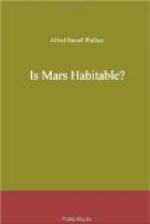“According to Sir Norman Lockyer’s Meteoritic Hypothesis, nebulae, comets, and many so-called stars consist of swarms of meteorites which, though normally cold and dark, are heated by repeated collisions, and so become luminous. They may even be volatilised into glowing meteoric vapour; but in time this heat is dissipated, and the force of gravity condenses a meteoritic swarm into a single globe. ’Some of the swarms are,’ says Lockyer, ‘truly members of the solar system,’ and some of these travel round the sun in nearly circular orbits, like planets. They may be regarded as infinitesimal planets, and so Chamberlain calls them ‘planetismals.’
“The planetismal theory is a development of the meteoritic theory, and presents it in an especially attractive guise. It regards meteorites as very sparsely distributed through space, and gravity as powerless to collect them into dense groups. So it assigns the parentage of the solar system to a spiral nebula composed of planetismals, and the planets as formed from knots in the nebula, where many planetismals had been concentrated near the intersections of their orbits. These groups of meteorites, already as dense as a swarm of bees, were then packed closer by the influence of gravity, and the contracting mass was heated by the pressure, even above the normal melting-point of the material, which was kept rigid by the weight of the overlying layers.”
Now, adopting this theory as the last word of science upon the subject of the origin of planets, we see that it affords immense scope for diversity in results depending on the total amount of matter available within the range of attraction of an incipient planetary mass, and the rates at which this matter becomes available. By a special combination of these two quantities (which have almost certainly been different for each planet) I think we may be able to throw some light upon the structure and physical features of Mars.
The Probable Mode of Origin of Mars.
This planet, lying between two of much greater mass, has evidently had less material from which to be formed by aggregation; and if we assume—as in the absence of evidence to the contrary we have a right to do—that its beginnings were not much later (or earlier) than those of the earth, then its smaller size shows that it has in all probability aggregated very much more slowly. But the internal heat acquired by a planet while forming in this manner will depend upon the rate at which it aggregates and




